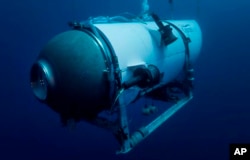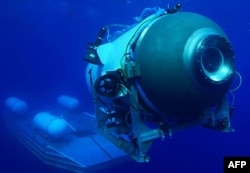Family and colleagues mourned the five people who died when the submersible imploded in the North Atlantic during a deep dive on its way to the wreckage of the Titanic on Friday, raising questions about safety rules for such adventures in the depths of the ocean. .
Debris from the Titan submersible, which had been missing since Sunday, was detected Thursday by a robotic diving vehicle deployed from a Canadian ship as part of an international rescue effort.
The remains of the submersible, which lost contact with a surface ship about 1 hour and 45 minutes after a 2-hour descent, were discovered on the seabed about 1,600 feet (488 meters) off the bow of the Titanic wreck, about 2-1/2 miles (4 km) below the surface, US Coast Guard Rear Admiral John Mauger said.
Mauger told reporters Thursday that the debris appeared to be the result of “a catastrophic implosion of the device.”
The victims include American Stockton Rush, founder and CEO of OceanGate Expeditions, which operated the submersible and charged $250,000 per person to make the trip to the Titanic. Rush was piloting the submersible.
The other victims are British billionaire and explorer Hamish Harding, 58; Pakistani businessman Shahzada Dawood, 48, and his son Suleman, 19, both British citizens; and French oceanographer Paul-Henri Nargeolet, 77.
“These men were true explorers who shared a distinctive spirit of adventure and a deep passion for exploring and protecting the world’s oceans,” OceanGate said.
Guillermo Söhnlein, who co-founded OceanGate with Rush in 2009, said Rush was “well aware” of the dangers of exploring the ocean depths.
“Stockton was one of the most astute risk managers I’ve ever met,” said Söhnlein, who left the company in 2013 and retained a minority stake.
British Titanic explorer Dik Barton paid tribute to the work of his friend Nargeolet, but noted problems that arose with the ship’s design and maintenance. “Everyone is wise after the event, but as we heard before, unfortunately there were a lot of red flags flying here,” he said, alluding to earlier warnings.
Questions about Titan’s safety were raised in 2018 during a symposium of submersible industry experts and in a lawsuit from OceanGate’s former head of marine operations, which was settled later that year.
Global media coverage of the search dwarfed the aftermath of a much larger disaster from the sinking of a migrant boat off Greece last week that killed hundreds of people.
international effort
Teams from the United States, Canada, France and Britain spent days exploring a vast expanse of open sea in search of the Titan.
Mauger of the US Coast Guard said it was too early to say when the event that led to Titan’s demise would have occurred.
The position of the debris relatively close to the wreck suggested that it would have occurred near the bottom of the descent on Sunday.
The US Navy monitors that part of the Atlantic for submarine activity and said an analysis of acoustic data detected “an anomaly consistent with an implosion or explosion” near the location of the submersible when communication with Titan was lost.
The acoustic data was immediately shared with the US Coast Guard-led unified command, according to Navy officials, who spoke on condition of anonymity. It was decided that the acoustic data was not definitive and the search and rescue mission had to continue.
A Navy official said that while it was not immediately clear what the cost to the Navy of the rescue effort would be, it was likely to be negligible.
Filmmaker James Cameron, who directed the 1997 Oscar-winning film “Titanic,” which did much to revive worldwide interest in the British ocean liner that sank in 1912, said he learned of the acoustic findings a day after the disappearance of the submersible and knew what it meant.
“I emailed everyone I know and told them that we had lost some friends. The submarine had imploded,” he told Reuters Cameron.
Scientist and journalist Michael Guillén, who survived an expedition in 2000 that got caught in the wreck’s propeller, said: “We need to stop, pause and ask this question, ‘why do you want to go to the Titanic and how do you get there? No danger?'”.
The Titanic sank after hitting an iceberg on its maiden voyage, killing more than 1,500 people on board. The remains lie about 900 miles (1,450 km) east of Cape Cod, Massachusetts, and 400 miles (640 km) south of St. John’s, Newfoundland.
Connect with the Voice of America! Subscribe to our channel Youtube and activate notifications, or follow us on social networks: Facebook, Twitter and instagram
















